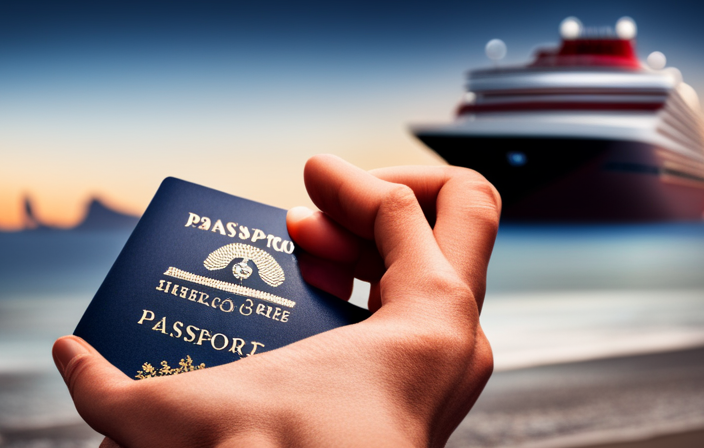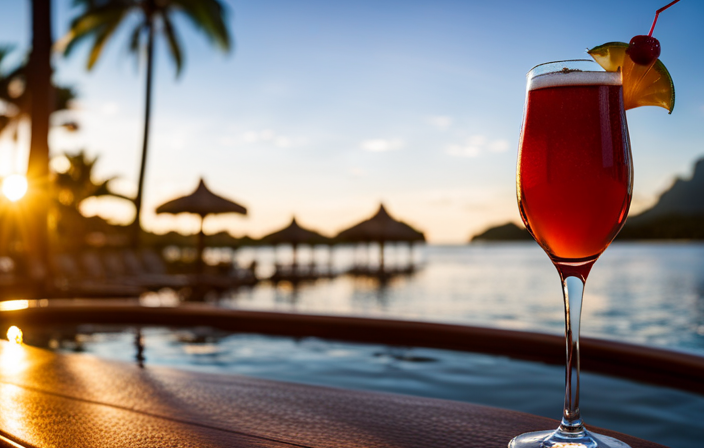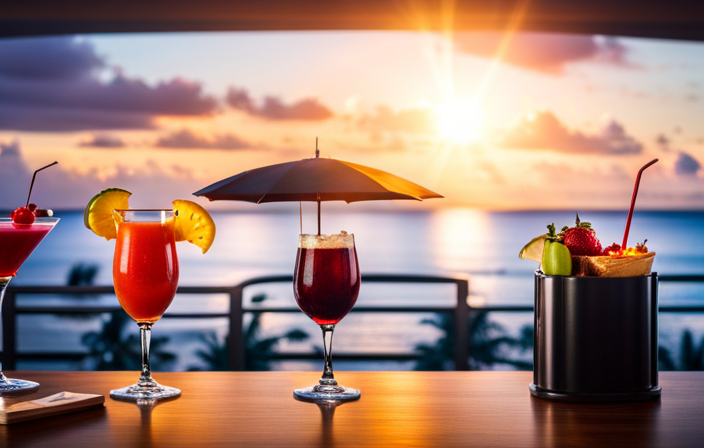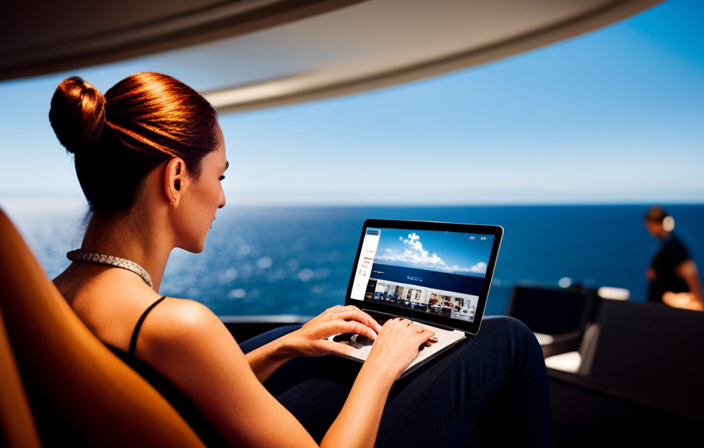Cruise News and Updates
Clean Power at Sea: Royal Caribbean’s Icon-Class Ships Set to Transform Maritime Industry
I’m thrilled to share the extraordinary progress related to Royal Caribbean’s Icon-Class Ships. These exceptional vessels are set to revolutionize the maritime industry by leveraging the power of liquefied natural gas (LNG) and fuel cell technology.
Thanks to a partnership with shipbuilder Meyer Turku, these state-of-the-art ships will be delivered in 2022 and 2024, accommodating around 5,000 passengers.
By embracing clean and efficient power sources, Royal Caribbean is leading the charge in reducing emissions and transforming the industry.
Get ready for a new era of sustainable cruising on the high seas.
Key Takeaways
- Royal Caribbean’s Icon-Class Ships will introduce fuel-cell technology to reduce greenhouse-gas emissions.
- The ships will primarily run on liquefied natural gas (LNG), which is gaining momentum in the maritime industry.
- The use of fuel cells and LNG will result in cleaner emissions and contribute to energy efficiency.
- The adoption of LNG power by Royal Caribbean and other cruise lines is leading to growth in ports supporting LNG infrastructure.
The Future of Maritime Industry: Royal Caribbean’s Icon-Class Ships
I’m excited about the future of the maritime industry with Royal Caribbean’s Icon-Class ships. These ships are set to transform the industry with their clean power technology. They will introduce fuel-cell technology to reduce greenhouse gas emissions. Royal Caribbean has already signed a memorandum of understanding with shipbuilder Meyer Turku. The Icon-Class ships are expected to be delivered in 2022 and 2024.
These ships will have a significant environmental impact as they can accommodate approximately 5,000 passengers. Fuel cells produce no sulfur and reduce nitrogen oxides and particulates, making them a cleaner alternative for powering a ship’s hotel functions. This shift towards clean power and the adoption of liquefied natural gas (LNG) as the primary fuel source will not only benefit the environment but also lead to growth in ports supporting LNG infrastructure.
The future of the maritime industry is bright with these future innovations.
Revolutionary Technology: Fuel Cell Power on Icon-Class Ships
Fuel cell technology is being tested and maximized on Royal Caribbean’s new Icon-class ships, offering exciting design possibilities and reducing greenhouse-gas emissions.
-
Fuel cell technology implementation on Icon-class ships:
-
Memorandum of understanding signed with shipbuilder Meyer Turku
-
Testing fuel cell technology on existing Oasis-class ship in 2017
-
Progressively larger fuel cell projects planned for new Quantum-class ships
-
Benefits of fuel cell power:
-
Fuel cells produce no sulfur and reduce nitrogen oxides and particulates
-
Energy efficiency and reduced emissions
-
Fuel cells offer design possibilities for powering ship’s hotel functions
-
Impact on the maritime industry:
-
Fuel cells represent a significant step forward for the industry
-
Limited experiments with fuel cell technology in the past
-
LNG adoption leads to growth in ports supporting it
The implementation of fuel cell technology on Icon-class ships not only reduces greenhouse-gas emissions but also offers promising design possibilities. The memorandum of understanding with shipbuilder Meyer Turku and the testing of fuel cell technology on existing ships demonstrate Royal Caribbean’s commitment to incorporating this technology.
With fuel cells producing no sulfur and reducing nitrogen oxides and particulates, the benefits of fuel cell power include energy efficiency and reduced emissions. Additionally, fuel cells offer interesting design possibilities for powering the ship’s hotel functions.
This revolutionary technology represents a significant step forward for the maritime industry, and the adoption of LNG as a power source is further driving growth in ports supporting it.
A Cleaner Future: LNG Adoption in the Maritime Industry
LNG adoption is gaining momentum in the maritime industry, with other cruise lines also embracing this cleaner fuel source. The expansion of LNG infrastructure is a key driver behind this shift.
LNG, or liquefied natural gas, offers several environmental benefits compared to traditional fuels. It produces lower sulfur emissions and reduces nitrogen oxides and particulate matter. This results in cleaner emissions and contributes to improved air quality.
The adoption of LNG power by cruise lines, such as Royal Caribbean, is leading to the growth of ports that support this fuel source. Moreover, LNG can also be used in conjunction with distillate fuel for ports that do not have LNG infrastructure in place.
Overall, the industry’s move towards LNG adoption is a positive step towards a cleaner and more sustainable future for the maritime industry.
Setting a New Standard: Energy Efficiency and Reduced Emissions
Using advanced technologies like air lubrication and AEP scrubbers, we can significantly improve energy efficiency and reduce emissions in the maritime sector. This is crucial for achieving environmental sustainability and ensuring a cleaner future for our oceans.
Here are four key ways in which energy-saving technology can make a positive impact:
-
Reduced Friction: Air lubrication technology reduces friction by creating microscopic bubbles, allowing ships to glide through water more efficiently and consume less fuel.
-
Cleaner Exhaust: AEP scrubbers clean exhaust gases before they are released into the atmosphere, removing harmful pollutants and minimizing the environmental impact.
-
Improved Design: Energy-saving technologies like fuel cells offer exciting design possibilities for powering a ship’s hotel functions, reducing reliance on traditional fossil fuels.
-
Industry Transformation: By adopting these energy-saving technologies, the maritime industry can set a new standard for energy efficiency and reduced emissions, leading the way towards a more sustainable future.
Fuel Cell Breakthrough: Transforming the Maritime Industry
I’m excited about the breakthrough in fuel cell technology and its potential to revolutionize the way ships operate in the maritime sector.
Fuel cells offer numerous benefits, particularly in terms of environmental impact. They produce no sulfur and significantly reduce nitrogen oxides and particulates. This means cleaner emissions and a positive step forward for the industry.
Royal Caribbean, known for their progress in energy efficiency, is taking the lead in testing and maximizing the use of fuel cells in their Icon-class ships. These ships, expected to accommodate approximately 5,000 passengers, are powered by liquefied natural gas (LNG) and will also incorporate fuel cell technology. This represents an interesting design possibility for powering the ship’s hotel functions.
The adoption of LNG in the maritime industry is gaining momentum, leading to growth in ports that support it.
Overall, fuel cell technology has the potential to greatly transform the maritime industry and contribute to a more sustainable future.
Maximizing Efficiency: Fuel Cell Integration in Icon-Class Ships
Maximizing the efficiency of fuel cell integration in the Icon-class ships is a key focus for Royal Caribbean. With advancements in fuel cell technology, Royal Caribbean aims to harness the environmental benefits of fuel cells in the maritime industry. By incorporating fuel cells into their ships, Royal Caribbean is taking a significant step forward in reducing greenhouse gas emissions and improving sustainability in the industry.
Fuel cells offer interesting design possibilities for powering the ship’s hotel functions, such as lighting, air conditioning, and other electrical needs. The table below highlights the environmental benefits and advancements in fuel cell technology that are being utilized in the Icon-class ships:
| Advancements | Environmental Benefits |
|---|---|
| Reduced emissions of sulfur, nitrogen oxides, and particulates | Cleaner air quality |
| Potential for zero-emission operation | Reduced greenhouse gas emissions |
| Design flexibility for powering ship’s hotel functions | Improved energy efficiency |
Port Infrastructure Growth: The Impact of LNG Adoption
Adopting liquefied natural gas (LNG) as a power source in the maritime industry leads to the growth of ports supporting cleaner energy options. The economic benefits of LNG adoption are significant, as it provides infrastructure commitments for suppliers and encourages the development of port facilities. With the increasing adoption of LNG power in the maritime industry, ports are expanding their capabilities to accommodate these vessels. This growth in port infrastructure not only enhances the operational efficiency of LNG-powered ships but also creates new job opportunities and drives economic growth in the surrounding areas.
Furthermore, LNG adoption has a positive environmental impact by reducing emissions in the maritime industry. LNG produces lower levels of sulfur, nitrogen oxides, and particulates compared to traditional fuels. This reduction in emissions contributes to improving air quality and mitigating the industry’s impact on climate change. As more ships transition to LNG, the overall environmental footprint of the maritime industry decreases, making it a more sustainable and responsible choice for transportation at sea.
Design Possibilities: Fuel Cells Powering Icon-Class Ships’ Functions
Fuel cells offer exciting design possibilities for powering various functions on the Icon-Class ships. The integration of fuel cells in these ships opens up new opportunities for energy efficiency and reduced emissions. Here are four key points to consider:
-
Enhanced Sustainability: Fuel cells produce no sulfur and significantly reduce nitrogen oxides and particulate emissions. This makes them a cleaner and more sustainable option for powering the ship’s hotel functions.
-
Versatile Power Source: Fuel cells can be used to power a range of functions on board, including lighting, heating, and ventilation systems. Their compact size and quiet operation make them ideal for integration into various ship systems.
-
Design Flexibility: The use of fuel cells allows for more flexible design options, as they can be installed in different areas of the ship. This ensures efficient use of space and enhances the overall design aesthetic.
-
Future Potential: By testing and maximizing the use of fuel cells in the Icon-Class ships, Royal Caribbean is paving the way for the wider adoption of this technology in the maritime industry. This could lead to significant advancements in clean power at sea.
Overall, the integration of fuel cells in the Icon-Class ships offers not only environmental benefits but also exciting design possibilities for a more sustainable future in the maritime industry.
Frequently Asked Questions
What Is the Expected Passenger Capacity of Royal Caribbean’s Icon-Class Ships?
The expected passenger capacity of Royal Caribbean’s Icon-Class ships is approximately 5,000. These ships will also have unique design features, including the use of fuel cell technology and the ability to run on LNG or distillate fuel.
When Are the Icon-Class Ships Scheduled to Be Delivered?
The Icon-class ships are scheduled to be delivered in 2022 and 2024. These ships are expected to accommodate approximately 5,000 passengers and will feature fuel-cell technology to reduce greenhouse-gas emissions.
Are Other Cruise Lines Also Adopting LNG Power?
Yes, other cruise lines are also adopting LNG power. LNG is gaining momentum in the maritime industry due to its infrastructure commitments for suppliers. It is expected that the Icon-class ships will primarily run on LNG.
What Are Some Technologies Used by Royal Caribbean to Improve Energy Efficiency and Reduce Emissions?
Some energy efficient systems used by Royal Caribbean to reduce emissions include air lubrication and AEP scrubbers. These technologies, along with sustainable propulsion methods like LNG, contribute to cleaner emissions and a more sustainable maritime industry.
How Do Fuel Cells Reduce Greenhouse Gas Emissions and Improve Air Quality?
Fuel cells reduce greenhouse gas emissions and improve air quality by producing no sulfur, reducing nitrogen oxides and particulates. They offer design possibilities for powering a ship’s hotel functions, maximizing their use in the maritime industry.
Claire, a creative soul with an unquenchable thirst for storytelling, is an integral part of the Voyager Info team. As a dedicated writer, she weaves captivating narratives that transport readers to enchanting cruise destinations and beyond.
Claire’s love affair with writing began at an early age when she discovered the magic of words and their ability to craft worlds and emotions. Her innate curiosity led her to explore various literary genres, but it was travel writing that truly captured her heart. Drawing inspiration from her own globetrotting adventures and encounters with diverse cultures, Claire embarked on a journey to become a travel writer par excellence.
Cruise News and Updates
Safely Experience And Support The Future Of Cruises In 2021
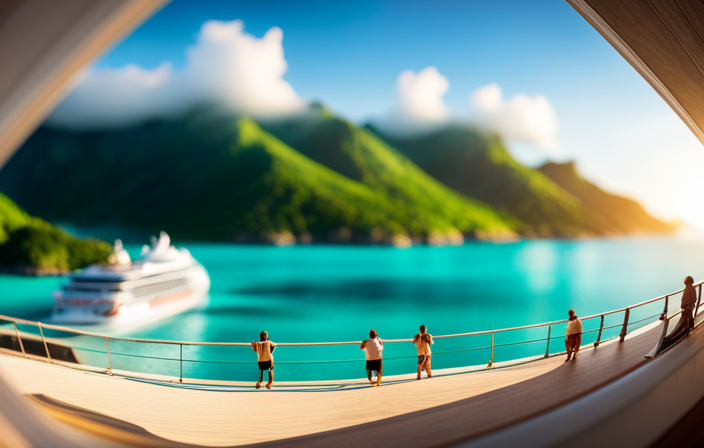
Howdy! While we make our way through the unpredictable challenges brought on by the global health crisis, the cruise industry is undoubtedly one of the hardest hit sectors. However, do not despair, fellow journey-seekers, as it appears that there is a glimmer of hope on the horizon!
In this article, we will delve into the exciting world of cruises in 2021 and explore how we can safely experience and support their future.
Like a sturdy anchor, the Centers for Disease Control and Prevention (CDC) has laid out requirements for test cruise volunteers, ensuring that we set sail with utmost caution. These requirements include being 18 years or older, fully vaccinated against COVID-19 or having no high-risk medical conditions, and agreeing to COVID-19 testing. These test cruises serve as a simulation, allowing cruise lines to fine-tune their operations and ensure the safety of both crew and passengers.
So, grab your life jackets and join me as we embark on a journey to discover the ins and outs of these test cruises. From embarkation to dining, entertainment to medical evacuation procedures, we will explore it all.
Let’s set sail and support the future of cruises in 2021!
Key Takeaways
- CDC requirements for test cruise volunteers include being 18 years or older, fully vaccinated against COVID-19 or having no high-risk medical conditions, and undergoing COVID-19 symptom evaluations before embarkation and disembarkation.
- The purpose of test cruises is to ensure safe operation during the global health crisis and simulate the passenger experience.
- Test cruises must be at least 2-7 days in duration with at least one overnight stay, and the CDC recommends a minimum voyage length of 3 days with 2 overnight stays.
- Simulated activities on test cruises include embarkation and disembarkation procedures, dining, entertainment, and medical evacuation procedures, isolation and quarantine measures, and protocols for recreational activities and shore excursions.
What is it?
I’ll explain what a test cruise is in 2021. A test cruise is a simulated voyage that cruise lines conduct to ensure safe operation despite the global health crisis. These cruises serve to test and evaluate the implementation of safety measures and protocols.
The purpose is to simulate the passenger experience and identify any areas that may need improvement. Test cruises typically last between 2-7 days, with at least one overnight stay. Safety is of utmost importance, and all volunteers must adhere to CDC requirements, such as being fully vaccinated against COVID-19 and undergoing pre and post-disembarkation COVID-19 testing.
While test cruises are not paid and cannot be part of employment conditions, volunteers have the opportunity to support the future of the cruise industry and contribute to the development of enhanced safety protocols.
Requirements for Volunteers
To volunteer for a test cruise in 2021, I must meet the CDC requirements, including being fully vaccinated against COVID-19 or having no high-risk medical conditions, and I must be willing to undergo COVID-19 testing before and after the cruise.
The evaluation process for volunteers will involve assessing their vaccination status and checking for any COVID-19 symptoms before embarkation and disembarkation.
The purpose of this evaluation is to ensure the safety of all participants and to simulate a real passenger experience. It is crucial for volunteers to comply with these requirements in order to support the future of cruises in 2021 and to help the industry operate safely amidst the global health crisis.
By following these guidelines, we can contribute to the development of effective protocols and measures that will allow cruise ships to resume operations in a responsible manner.
Test Cruise Details
The test cruises will have a duration of 2-7 days and will include at least one overnight stay. These cruises are designed to simulate the passenger experience and ensure safe operation despite the ongoing global health crisis. During the test cruises, various activities will be simulated, including embarkation and disembarkation procedures, dining, entertainment, and medical evacuation protocols.
Additionally, there will be simulated recreational activities such as casinos and spa services, as well as protocols for private-island and port of call shore excursions.
As for the sign-up process and selection for test cruises, currently, only Royal Caribbean has provided a sign-up form for volunteers. In the first week, they received 100,000 signatures. However, there haven’t been any announcements or updates regarding sign-up methods from Norwegian, Carnival, MSC, and Disney. The volunteer selection process for test cruises hasn’t been disclosed at this time.
Frequently Asked Questions
Can I bring my own food and beverages on a test cruise?
On a test cruise, passengers are not allowed to bring their own food and beverages. The cruise line provides all meals and drinks as part of the simulated passenger experience. Dietary restrictions can be accommodated upon request.
Will test cruise volunteers have access to all onboard amenities and services?
Test cruise volunteers are expected to have access to all onboard amenities and services. However, it is important to note that volunteers are not compensated for their participation in the test cruises.
Are there any restrictions on the number of passengers allowed on a test cruise?
Passenger capacity limits for test cruises are determined by the CDC. However, cruise lines that require vaccinations for passengers can bypass test cruises. Vaccination requirements are in place to ensure the safety of all participants.
How often will test cruises be conducted in 2021?
Test cruises will be conducted multiple times in 2021 as part of the cruise industry recovery and to ensure health and safety measures. The exact frequency of test cruises has not been specified.
Will test cruise volunteers be compensated in any way for their participation?
Test cruise volunteers will not be compensated for their participation. However, they will benefit from the opportunity to experience a simulated cruise, contribute to the safe operation of cruises, and help shape the future of the industry.
Claire, a creative soul with an unquenchable thirst for storytelling, is an integral part of the Voyager Info team. As a dedicated writer, she weaves captivating narratives that transport readers to enchanting cruise destinations and beyond.
Claire’s love affair with writing began at an early age when she discovered the magic of words and their ability to craft worlds and emotions. Her innate curiosity led her to explore various literary genres, but it was travel writing that truly captured her heart. Drawing inspiration from her own globetrotting adventures and encounters with diverse cultures, Claire embarked on a journey to become a travel writer par excellence.
Cruise News and Updates
How Cruise Ships Operate: Profits, Strategies, And Continuous Operation
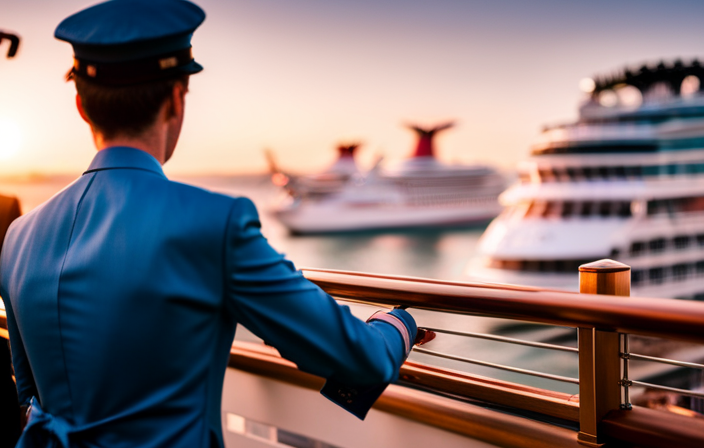
Hello! We are excited to invite you to explore the captivating world of cruise ships and learn about how they operate.
Picture this: cruise ships, those floating paradises on the sea, are not only about providing unforgettable vacations but also about generating impressive profits. In this article, we’ll explore the strategies and continuous operation that keep these magnificent vessels afloat financially.
Did you know that ticket prices for mainstream cruise lines average around $1,293? But that’s just the beginning. Additional onboard spending can add up to a whopping $429 per passenger. From casinos to spas, shopping to dining, and everything in between, cruise lines have cleverly designed their ships to maximize revenue from various sources.
But it doesn’t stop there. We’ll also uncover the secrets behind the ownership and categorization of cruise lines. From Carnival Corporation to Royal Caribbean Group and Norwegian Cruise Line Holdings, these three corporations dominate the industry with their multiple brands.
So, fasten your seatbelts (or life jackets) and get ready to embark on a journey through the intriguing world of cruise ship operations.
Let’s set sail!
Key Takeaways
- Cruise ship ticket prices include both the base fare and additional onboard spending, such as casinos, spas, shopping, dining, Wi-Fi, and drinks.
- Main sources of profit for cruise lines are casinos, spas, shopping, dining, Wi-Fi, and drinks.
- Placement of common areas like lounges, bars, and casinos strategically along passenger routes helps generate more revenue.
- Cruise lines employ various profit-making strategies, such as making most of the money upfront for premium cruise lines and catering to passengers who spend more time in ports for luxury cruise lines.
How They Make Money
I make money by offering various sources of entertainment and amenities on board, such as casinos, spas, shopping, dining, Wi-Fi, and drinks. These are the key sources of profit for cruise lines. Onboard revenue sources are crucial in generating income for the company.
Passengers spend money on these amenities and entertainment options, contributing to the overall profitability of the cruise line. Additionally, we generate revenue through passenger spending on private islands. By leasing private islands from foreign countries, we provide passengers with unique experiences, such as complimentary beach chairs and BBQ lunches. This not only enhances their vacation but also increases their spending on the island.
These onboard revenue sources and passenger spending on private islands play a significant role in ensuring the financial success of the cruise line.
Continuous Operation Process
Year-round, cruise liners tirelessly navigate the seas, seamlessly switching regions during repositioning cruises, and swiftly preparing for the next voyage on turnaround day. Crew management plays a crucial role in ensuring continuous operation. Cruise lines hire crew members from foreign countries, allowing them to save costs while maintaining a diverse and efficient workforce. These crew members work tirelessly to provide exceptional service to passengers, ensuring their comfort and satisfaction throughout the voyage.
Repositioning cruises are another aspect of continuous operation. These cruises occur when ships move from one region to another, often during seasonal changes. During repositioning cruises, cruise lines take the opportunity to offer unique itineraries and experiences to passengers. This allows them to generate additional income while optimizing the usage of their fleet.
Incorporating a 3 column and 5 row table:
| Continuous Operation Process | |
|---|---|
| Year-round operation | Without breaks |
| Repositioning cruises | Ships switch regions |
| Turnaround day | Quick disembarkation and preparation for the next cruise |
| Crew management | Hiring crew members from foreign countries |
| Additional income | Visiting multiple ports |
Ownership and Categorization
Carnival Corporation, Royal Caribbean Group, and Norwegian Cruise Line Holdings are the three corporations that own multiple cruise line brands. These corporations have a complex ownership structure, with each owning several cruise lines that cater to different market segments.
Carnival Corporation, for example, owns popular mainstream brands such as Carnival Cruise Line and Princess Cruises, while Royal Caribbean Group owns premium brands like Royal Caribbean International and Celebrity Cruises. Norwegian Cruise Line Holdings, on the other hand, owns Norwegian Cruise Line, which falls into the mainstream category.
Differentiation factors play a crucial role in the ownership structure. Each corporation strategically positions its cruise line brands to cater to different types of passengers. This allows them to capture a wider market share and maximize profits.
From mainstream to luxury, these corporations have created a diverse range of cruise lines that offer unique experiences and amenities. By offering different levels of service, accommodations, and onboard activities, they are able to attract and retain passengers with varying preferences and budgets.
The ownership and categorization of cruise line brands play a significant role in the overall profitability and success of these corporations.
Frequently Asked Questions
How do cruise ships handle medical emergencies and provide medical care to passengers on board?
Cruise ship medical facilities are equipped to handle medical emergencies. The crew receives emergency response training, and medical personnel are available on board. Passengers can receive medical care and treatments while at sea.
What safety measures are in place to prevent accidents or incidents on cruise ships?
Cruise ship safety measures include thorough training for crew members, regular safety drills, strict adherence to international safety regulations, advanced navigation systems, surveillance cameras, and emergency response protocols to prevent accidents and incidents onboard.
How do cruise ships handle waste management and environmental sustainability?
Ah, waste management and environmental sustainability, the unsung heroes of cruising. Cruise ships tackle these challenges through advanced waste treatment systems, recycling programs, and energy-efficient technologies, ensuring a greener voyage for all.
What is the process for hiring and training crew members on cruise ships?
The hiring process for crew members on cruise ships involves recruiting from foreign countries, conducting interviews and background checks, and providing training in various areas such as safety, customer service, and emergency procedures.
How do cruise ships handle security and ensure the safety of passengers and their belongings?
Cruise ship security is a top priority, ensuring passenger safety and protecting their belongings. Vigilant surveillance systems, trained security staff, and strict access control measures are implemented to prevent incidents and swiftly respond to emergencies.
Claire, a creative soul with an unquenchable thirst for storytelling, is an integral part of the Voyager Info team. As a dedicated writer, she weaves captivating narratives that transport readers to enchanting cruise destinations and beyond.
Claire’s love affair with writing began at an early age when she discovered the magic of words and their ability to craft worlds and emotions. Her innate curiosity led her to explore various literary genres, but it was travel writing that truly captured her heart. Drawing inspiration from her own globetrotting adventures and encounters with diverse cultures, Claire embarked on a journey to become a travel writer par excellence.
Cruise News and Updates
The Fascinating World Of Cruise Ships: Size, Power, And Environmental Impact
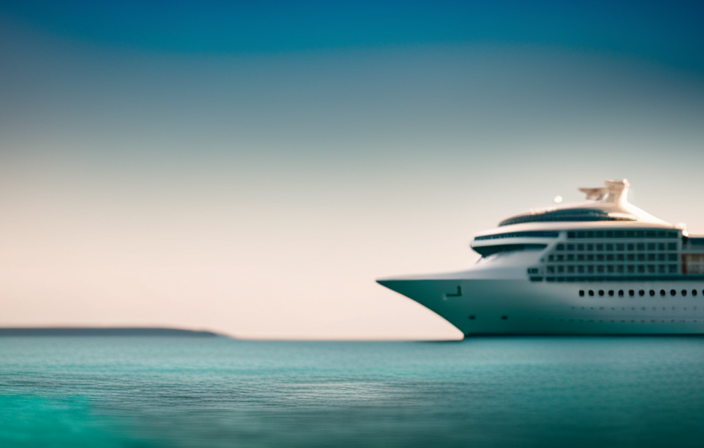
Oh, the world of cruise ships. It’s a mesmerizing realm, filled with magnificent vessels sailing the vast oceans, taking passengers to distant, enchanting locations.
The sheer size and power of these floating marvels never fail to astound me. From their towering lengths, ranging from 900 to 1,100 feet, to their impressive fuel tanks, holding a staggering 1 to 2 million gallons of fuel, cruise ships are a testament to human engineering. Some even harness the energy of liquefied natural gas, with engines so colossal they could fill a room. It’s truly awe-inspiring.
Yet, amidst this marvel, we must also consider the environmental impact. Many cruise lines still rely on diesel-powered engines, but the use of LNG reduces carbon emissions by a significant 30%.
As a passionate traveler and writer, I am eager to delve into the fascinating world of cruise ships, exploring their size, power, and environmental impact. Join me as we embark on this journey of discovery and exploration.
Key Takeaways
- Cruise ships are massive vessels that can range in length from 900 to 1,100 feet.
- Some cruise ships use liquefied natural gas (LNG) as fuel, reducing carbon emissions by 30%.
- The environmental impact of cruise ships, particularly diesel-powered engines, is a concern and contributes to air pollution and climate change.
- The adoption of sustainable cruise practices, including the use of LNG fuel, is crucial for a more sustainable future and to mitigate the environmental impact of cruise ships.
Cruise Ship Specifications
Cruise ship specifications are an important aspect to consider when understanding their size, power, and environmental impact. These massive vessels can range in length from 900 to 1,100 feet, accommodating thousands of passengers and crew members.
Fuel consumption is a significant consideration, with cruise ships typically carrying 1-2 million gallons of fuel in their tanks. Some ships are now incorporating LNG tanks, which reduce carbon emissions by 30%.
The shipbuilding process is a complex endeavor, with engines playing a crucial role in powering these floating cities. Cruise ships are equipped with 4-6 engines, each generating an impressive 18.5 megawatts of power. These engines, measuring up to 45 feet in length and 27 feet in height, propel the ship at an average speed of 18-22 knots.
Additionally, cruise ships are equipped with two anchors weighing 10-20 tons each, ensuring stability while at port.
Engine and Power Details
When it comes to engine and power details, it’s important to consider the environmental impact and the need for alternative fuel sources.
Cruise ship propulsion plays a crucial role in determining the ship’s fuel efficiency and carbon emissions. Most cruise ships are equipped with 4-6 engines, each generating 18.5 megawatts of power. These engines can measure up to 45 feet in length and 27 feet in height.
While many cruise lines still rely on diesel-powered engines, there is a growing shift towards using liquefied natural gas (LNG) as a more environmentally friendly fuel source. LNG-powered ships can reduce carbon emissions by up to 30%.
As the cruise industry continues to evolve, it’s crucial for shipbuilders and operators to prioritize fuel efficiency and explore sustainable propulsion options to minimize their environmental impact.
Environmental Impact
As an enthusiast of the cruise industry, I am deeply concerned about the ecological consequences of traditional diesel-powered engines commonly used on cruise ships. Cruise ship emissions have a significant impact on the environment, contributing to air pollution and climate change. However, there are sustainable cruise practices being implemented to address these concerns. One such practice is the use of LNG-powered fuel, which reduces carbon emissions by 30% compared to diesel. This is a positive step towards minimizing the environmental impact of cruise ships.
To visualize this information, here is a table highlighting the environmental impact of cruise ship emissions:
| Environmental Impact | Consequences |
|---|---|
| Air pollution | Increased respiratory |
| problems | |
| Climate change | Rising sea levels |
| and extreme weather |
By adopting sustainable cruise practices and transitioning to cleaner fuel sources like LNG, cruise ships can help mitigate their environmental footprint and contribute to a more sustainable future.
Frequently Asked Questions
What are some popular destinations for cruise ships?
Top rated cruise ship destinations include the Caribbean, Mediterranean, Alaska, and the Baltic Sea. These locations offer stunning scenery, cultural experiences, and a variety of activities. The cruise industry is adopting eco-friendly practices to reduce its environmental impact.
How many passengers can a typical cruise ship accommodate?
A typical cruise ship can accommodate thousands of passengers, resembling a floating city. With various cruise ship designs catering to different market segments, the cruise ship market continues to evolve to meet the needs of travelers worldwide.
What are some unique amenities or features found on modern cruise ships?
Luxury accommodations and innovative dining experiences are some unique amenities found on modern cruise ships. Passengers can enjoy spacious suites, private balconies, gourmet restaurants, and specialty dining options that cater to various tastes and dietary preferences.
How do cruise ship companies ensure the safety and security of their passengers?
Cruise ship companies ensure the safety and security of their passengers through various measures. They have well-equipped medical facilities onboard and conduct regular emergency drills to prepare passengers for any potential emergencies that may arise during their voyage.
What are some common activities or entertainment options available on cruise ships?
Cruise ships offer a wide range of activities and entertainment options. From gourmet dining experiences to luxurious onboard spa and wellness facilities, passengers can indulge in relaxation and enjoy a variety of amenities during their cruise vacation.
Claire, a creative soul with an unquenchable thirst for storytelling, is an integral part of the Voyager Info team. As a dedicated writer, she weaves captivating narratives that transport readers to enchanting cruise destinations and beyond.
Claire’s love affair with writing began at an early age when she discovered the magic of words and their ability to craft worlds and emotions. Her innate curiosity led her to explore various literary genres, but it was travel writing that truly captured her heart. Drawing inspiration from her own globetrotting adventures and encounters with diverse cultures, Claire embarked on a journey to become a travel writer par excellence.
-

 Cruise FAQs3 days ago
Cruise FAQs3 days agoHow To Turn On Cruise Control Tesla Model 3
-

 Cruise FAQs3 months ago
Cruise FAQs3 months agoWhat Is The Weather Like On A Transatlantic Cruise In April
-

 Cruise FAQs3 days ago
Cruise FAQs3 days agoHow To Set Cruise Control Tesla Model Y
-

 Cruise FAQs3 months ago
Cruise FAQs3 months agoHow to Contact Someone on a Carnival Cruise Ship
-
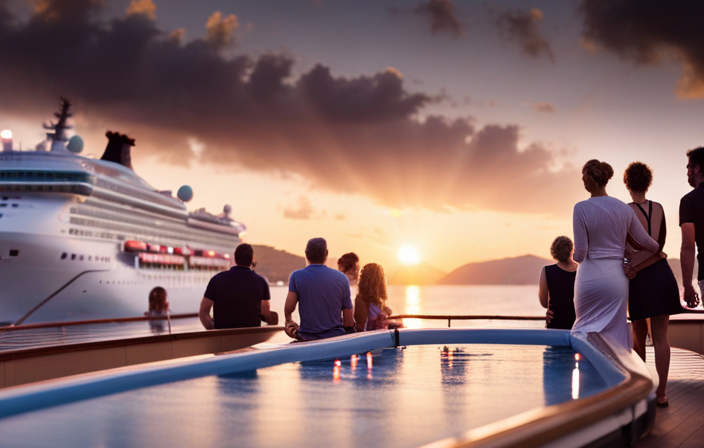
 Cruise Lines3 months ago
Cruise Lines3 months agoWhat Is The Average Age Of Passengers By Cruise Line
-

 Onboard Experience1 week ago
Onboard Experience1 week agoFinding Deals On Unsold Cruise Cabins: Tips And Strategies
-
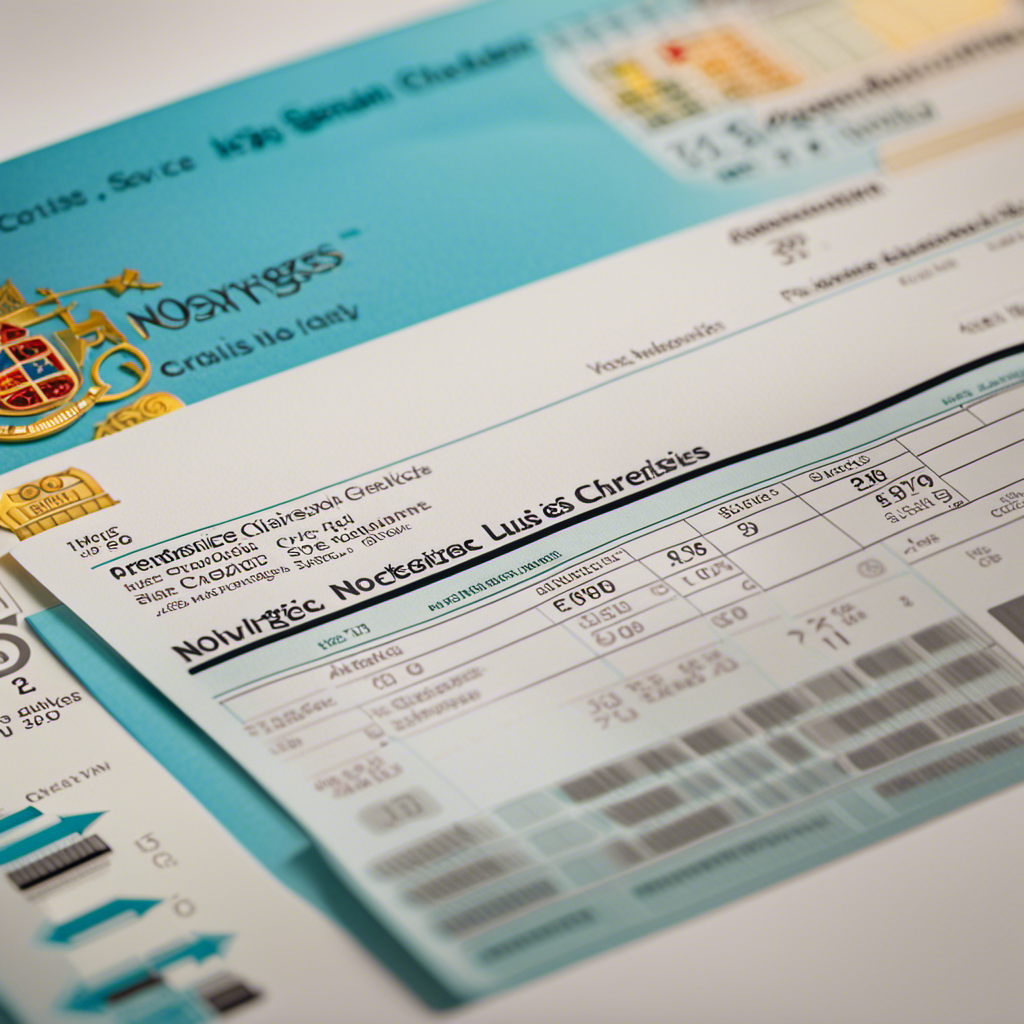
 Cruise Lines3 months ago
Cruise Lines3 months agoDecoding Norwegian Cruise Line’s Gratuities and Service Charges
-
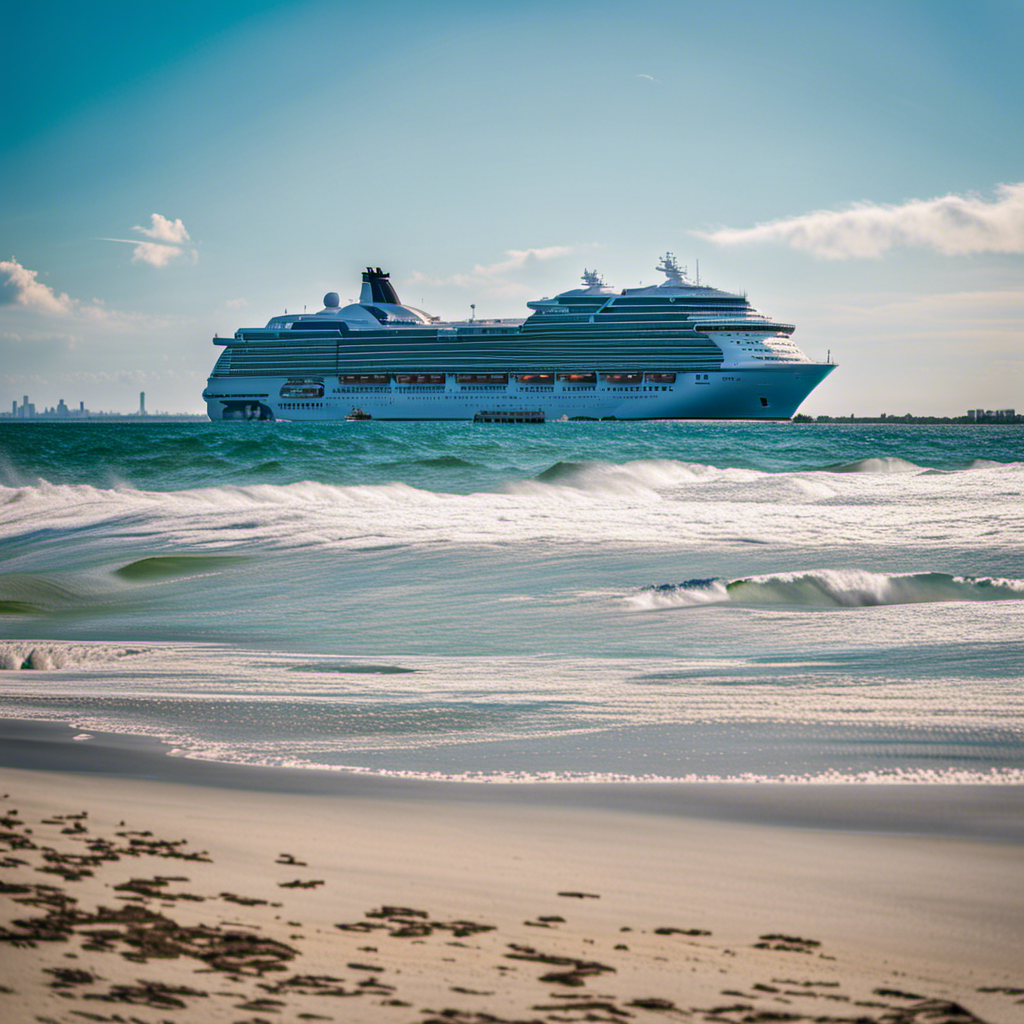
 Cruise Lines3 months ago
Cruise Lines3 months agoWhat Cruise Lines Depart From North Carolina







